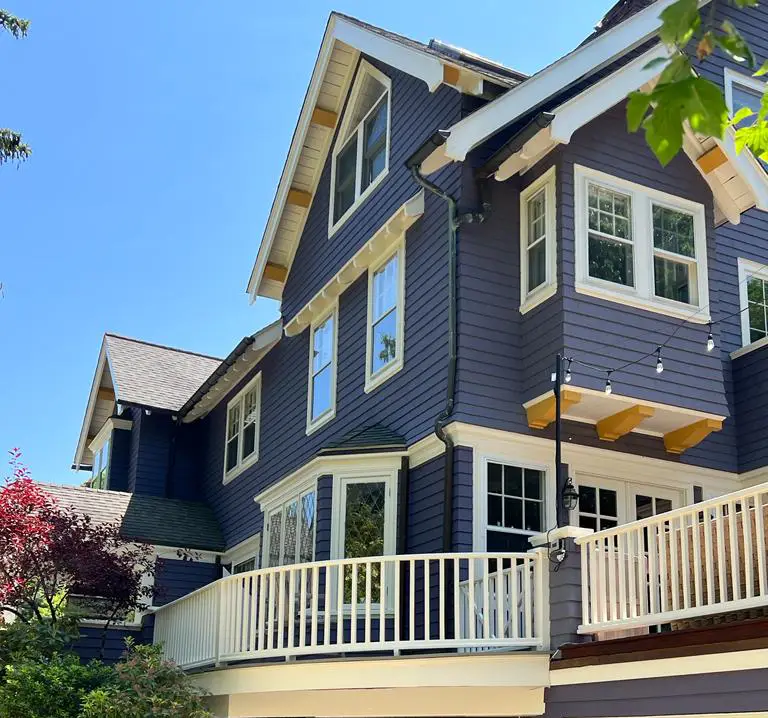Blogs

How to Paint Aluminum Window Frames | DIY Painting Tips
Aluminum window frames are a durable and practical choice, but over time, their factory finish can fade, get scuffed, or simply fall out of style. Instead of the significant expense of full window replacement, painting your aluminum frames can offer a dramatic and cost-effective transformation, revitalizing your home's curb appeal. While it's a meticulous task, it's entirely achievable for the diligent DIYer. Masterpiece Painter outlines the essential tools, materials, and step-by-step instructions to help you successfully paint your aluminum window frames for a lasting, professional-looking finish.
Tools and materials you’ll need
Before you begin, gather all necessary tools and materials. Having everything on hand will make the process smoother and more efficient.
Tools:
Safety Glasses and Gloves: Essential for protection.
Drop Cloths or Plastic Sheeting: To protect floors, walls, and surrounding areas.
Painter's Tape (High-Quality): Crucial for masking off glass and adjacent surfaces for clean lines.
Screwdrivers/Drill: For removing window hardware.
Buckets: For cleaning solutions and rinse water.
Sponges or Soft Brushes: For cleaning.
Degreaser or Mild Detergent: For deep cleaning.
Wire Brush (optional, for rust): If dealing with any minor rust spots.
Sandpaper (220-grit): For light scuffing. A sanding sponge can be easier for contours.
Tack Cloths: For removing fine dust after sanding.
Non-Contact Voltage Tester: If you suspect any electrical components (rare for window frames, but good to have for general home safety).
Paint Brushes (High-Quality Synthetic): 1-inch to 2-inch angled brushes for precise cutting-in.
Small Foam Roller (optional): For smooth, flat sections of wider frames.
Paint Tray: If using a roller or brushing from a tray.
Materials:
Rust Inhibiting Primer (if needed): For any areas of rust.
Direct-to-Metal (DTM) Primer: An acrylic or epoxy-based primer specifically for non-ferrous metals like aluminum. Look for excellent adhesion properties.
100% Acrylic Exterior Latex Paint: Choose a paint specifically labeled as "vinyl-safe" or with "Cool Color Technology" if opting for a dark color, to prevent heat absorption and warping.
Paint Thinner/Cleaner (for brush cleanup): If not using water-based paint.
Clean Rags or Microfiber Cloths: For wiping and drying.
Surface prep: Clean, sand, prime
Proper preparation is the most critical phase of painting aluminum. Skimping here guarantees a failed paint job.
Remove Hardware & Mask:
Carefully detach any removable window hardware such as latches, locks, and handles. Place them in a secure spot.
Use high-quality painter's tape to meticulously mask off all areas you don't want painted, including the glass panes, weatherstripping, window sills, and any adjacent walls or trim. Press the tape down firmly with a putty knife or your fingernail to ensure a sharp, clean line and prevent paint bleed. Lay down drop cloths to protect the floor/ground below.
Thorough Cleaning:
Initial Wipe: Use a damp cloth to wipe away any loose dirt, dust, and cobwebs.
Degrease & Scrub: Mix a strong degreaser or a mild detergent with water. Using a sponge or soft brush, thoroughly scrub the entire surface of the aluminum frames. Pay extra attention to corners, crevices, and any areas with built-up grime, mildew, or chalky residue (oxidation).
Rinse Completely: Rinse the frames meticulously with clean water. Any leftover soap or cleaner residue will prevent proper paint adhesion. Use multiple rinses if necessary.
Dry Completely: Allow the frames to air dry completely. This is crucial; moisture trapped beneath the paint will lead to bubbling and peeling. This may take several hours, or even overnight, depending on humidity.
Address Rust (If Applicable):
If you find any minor rust spots (though less common on aluminum than steel), use a wire brush or fine-grit sandpaper (e.g., 220-grit) to gently remove the rust.
Wipe away all dust.
Apply a rust-inhibiting primer (specifically designed for metal and often high-heat compatible) to the rusted areas, feathering the edges. Allow to dry.
Light Sanding/Scuffing:
Once the frames are clean and dry, use 220-grit sandpaper or a sanding sponge to lightly scuff the entire surface of the aluminum. The goal is to dull any existing sheen and create a "tooth" for the primer to adhere to. You are not trying to remove the existing finish, just to create micro-scratches.
After sanding, use a tack cloth or a slightly damp (with clean water) cloth to thoroughly wipe away all sanding dust. Let the frames dry again if using a damp cloth.
Choosing the right primer and paint
Selecting the correct products is paramount for longevity and proper adhesion on aluminum.
Primer:
Type: You MUST use a Direct-to-Metal (DTM) Primer. Look for acrylic or epoxy-based formulations specifically designed for non-ferrous metals like aluminum. These primers are engineered for superior adhesion to smooth, challenging surfaces.
Purpose: The primer acts as a bonding agent between the aluminum and your topcoat paint, and often provides corrosion resistance.
Paint:
Type: Opt for a 100% Acrylic Exterior Latex Paint. Acrylic paints are flexible, allowing them to expand and contract with the aluminum frames in response to temperature changes, which minimizes cracking and peeling. They also offer excellent durability and color retention.
"Vinyl-Safe" / "Cool Color" Technology (Crucial for Darker Colors): If you are choosing a paint color significantly darker than the original frame color, ensure the paint explicitly states "vinyl-safe" or features "Cool Color Technology." These paints contain specialized pigments that reflect sunlight, preventing the aluminum (and underlying paint layers) from absorbing excessive heat, which can lead to warping or blistering.
Sheen: Satin or semi-gloss finishes are generally recommended for window frames. They are durable, easy to clean, and provide a subtle sheen that complements most architectural styles.
Step-by-step application process
Once prepped and armed with your chosen heat-resistant paint, follow these steps for a smooth application:
Prime the Frames:
Apply the DTM primer in thin, even coats using your synthetic brush. Focus on achieving uniform coverage without drips or heavy spots.
Follow the primer manufacturer's instructions precisely for drying time before applying the topcoat. Rushing this step will compromise adhesion.
Apply the First Coat of Paint:
Ensure the primed frames are completely dry.
Stir your 100% acrylic exterior latex paint thoroughly.
Using your high-quality synthetic brush (and optionally a small foam roller for flat areas), apply the first coat of paint in thin, even layers. Work with the length of the frame.
Maintain a "wet edge" as you go to avoid visible lap marks, especially on larger, flat sections.
Weather Conditions: Paint on a day with moderate temperatures (50-85°F / 10-29°C) and low to moderate humidity. Avoid painting in direct, scorching sunlight, as this can cause the paint to dry too quickly, leading to brush marks, blistering, or poor adhesion. Overcast days or painting when the frames are in the shade are ideal.
Allow Proper Drying Time:
Consult your paint can for the recommended recoat time between coats. This is crucial for proper adhesion and durability. It can range from 2-4 hours to overnight.
Second Coat (and Third if needed): Once the first coat is dry to the touch, apply a second thin, even coat. This will ensure full coverage and maximum durability. A third coat might be necessary for full coverage, especially if you're going from a dark color to a light one.
Curing Time & Reassembly:
After the final coat, allow the paint to cure completely before putting stress on the painted frames or reattaching hardware. This can take several days (24-72 hours or more, depending on paint type and conditions).
Once fully cured, carefully remove the painter's tape (pulling it off at a 45-degree angle while the paint is still slightly tacky, or after it's fully dry, cutting along the edge with a utility knife to prevent lifting).
Reattach all removed hardware.
Tips for durability and a smooth finish
Cleanliness is Godliness: Reiterate that a spotless, dust-free surface is the absolute key to adhesion.
Thin Coats are Best: Always apply multiple thin coats rather than one thick coat. This prevents drips, bubbling, and promotes proper curing.
High-Quality Products: Investing in good brushes, rollers, primer, and paint will pay off in a smoother finish and increased longevity.
Patience: Don't rush the drying and curing times between coats. This is where many DIY projects fail.
Ventilation: Ensure good airflow, especially when painting indoors or in enclosed spaces, to help with drying and dissipate fumes.
When to consider professional help
While a DIY approach can save money, some situations warrant calling in a professional painter like Masterpiece Painter to ensure a flawless and lasting result.
Extensive Damage: If your aluminum frames have significant corrosion, deep pitting, or show signs of structural issues, a professional can assess if painting is viable or if replacement is the only option. They also have specialized tools for extensive rust removal and preparation.
High or Hard-to-Reach Windows: Painting second or third-story windows, or those requiring ladders, scaffolding, or specialized safety equipment, poses significant risks for DIYers. Professionals have the training and gear to do this safely.
Large Number of Windows: If you have numerous windows, the sheer time and meticulous effort required can be overwhelming. A professional team can complete the job efficiently and with consistent quality across all frames.
Desire for a Flawless Finish: Achieving a perfectly smooth, factory-like finish, especially with spray application, requires professional skill and equipment.
Time Constraints: If you need the project completed quickly and without consuming your valuable free time.
Uncertainty About Paint/Primer Choice: A professional painter can correctly identify the heater type, assess its condition, and recommend the exact heat-resistant paints and primers needed for optimal results.
Integrated Heating Systems: If your baseboard heaters are part of a complex hydronic system that you're unsure how to properly shut down and restart, a professional can coordinate with an HVAC technician if needed.
For a durable, safe, and beautifully integrated finish on your baseboard heaters, leveraging the expertise of Masterpiece Painter ensures your investment is well-placed, giving your home a polished and comfortable feel.
Ready to revitalize your window frames? Contact Masterpiece Painter today for a consultation and a professional quote to transform your space!
About Masterpiece Painter
For over 17 years Masterpiece Painter, has been serving communities all around New England. Let us help you make your wishes come true by turning your property into a Masterpiece
Get a Quote

© copyright 2023 All Rights Reserved.



